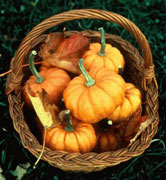


Home
Flowers &
Indoor Plants
Fruits & Nuts
Ornamentals
Vegetables
Special Topics
Resources
Glossary

|
Pumpkin Cucurbita pepo var. pepo (cue-kur-bit-ah pep-oh) 




|
 |
What about it? Pumpkins are members of the Gourd family and for all practical purposes they can be considered just another squash. In fact, pumpkin is a term that used to refer to many different types of .squashes. Now the term only refers to the large, round, orange fruit carved into jack-o-lanterns for Halloween. Many squashes try to get passed off as pumpkins, but true pumpkins have a star-shaped stem. What is it used for? The pumpkin was once considered much more versatile a vegetable than it is today. Perhaps the pumpkin fell from grace with modern home gardeners because it requires a large growing space. However, the insides of pumpkins are used in soups, casseroles, pies, and muffins. The smaller sized-pumpkins, such as 'Small Sugar; generally taste better than the larger ones. Also, the seeds can be roasted and eaten as a snack Where does it grow? How do we grow it? Although they require a lot of growing room and have a long growing season of 75-100 days, pumpkins are easy to grow and have relatively few problems. Before you plant, decide want kind of pumpkin you want to grow. There are varieties that produce copious amounts of seeds but have little flesh for cooking. There are large pumpkins for carving and small pumpkins for pies. Make your decision and buy the proper seed. And make plenty of room in your garden for the pumpkin patch. Like their relatives, the squashes, pumpkins like to be planted in hills. They also need a consistent supply of water. What are its primary problems? Cucumber beetles are a likely visitor to the pumpkin patch as soon as the first leaves appear. Squash bugs and squash vine borers may arrive later. Viruses transmitted by aphids may result in mosaic on leaves and occasionally on the fruit. Powdery mildew is a serious problem because it causes early vine death. How do we propagate it? Sow seeds directly in the garden after all danger of frost has passed. Make the hills 2 or 3 feet apart and plant the seeds in circles that are 6 inches across. How do we harvest and store it? Unless there is a threat of a frost, do not harvest your pumpkins until the vines die and fall off from the stem. When picking, try not to hold the pumpkins by their stems. If they fall off the pumpkin is prone to rotting. If you happen to have to harvest some unripe pumpkins, put them in a bag full of apples. Apples emit ethylene gas that will ripen the pumpkins from green to orange. Pumpkins will keep a couple of months at 45-50 degrees F. If you cure them at 60 degrees for 2 weeks they will store for an even longer period.
© Copyright, Department of Horticulture, Cornell University. |